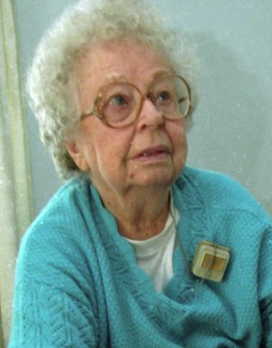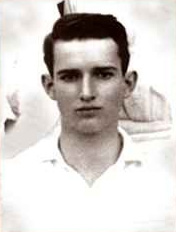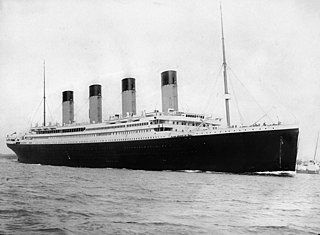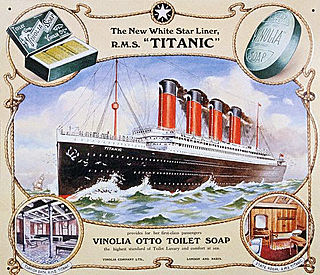
RMS Olympic was a British ocean liner and the lead ship of the White Star Line's trio of Olympic-class liners. Olympic had a career spanning 24 years from 1911 to 1935, in contrast to her short-lived sister ships, Titanic and Britannic. This included service as a troopship during the First World War, which gained her the nickname "Old Reliable", and during which she rammed and sank the U-boat U-103. She returned to civilian service after the war, and served successfully as an ocean liner throughout the 1920s and into the first half of the 1930s, although increased competition, and the slump in trade during the Great Depression after 1930, made her operation increasingly unprofitable. Olympic was withdrawn from service and sold for scrap on 12 April 1935 which was completed in 1937.

HMHSBritannic was the third and final vessel of the White Star Line's Olympic class of steamships and the second White Star ship to bear the name Britannic. She was the youngest sister of the RMS Olympic and the RMS Titanic and was intended to enter service as a transatlantic passenger liner. She was operated as a hospital ship from 1915 until her sinking near the Greek island of Kea, in the Aegean Sea, in November 1916. At the time she was the largest hospital ship in the world.

Romsey is a town in the Test Valley district of Hampshire, England. The town is situated 7 miles (11 km) northwest of Southampton, 11 miles (18 km) southwest of Winchester and 17 miles (27 km) southeast of Salisbury. It sits on the outskirts of the New Forest, just over 3 miles (4.8 km) northeast of its eastern edge. The population of Romsey was 14,768 at the 2011 census.

Harold Sydney Bride was a British merchant seaman and the junior wireless officer on the ocean liner RMS Titanic during her ill-fated maiden voyage.

Edward John Smith was a British sea captain and naval officer. In 1880, he joined the White Star Line as an officer, beginning a long career in the British Merchant Navy. Smith went on to serve as the master of numerous White Star Line vessels. During the Second Boer War, he served in the Royal Naval Reserve, transporting British Imperial troops to the Cape Colony. Smith served as captain of the ocean liner Titanic, and went down with the ship when she sank on her maiden voyage.

RMS Oceanic was a transatlantic ocean liner built for the White Star Line. She sailed on her maiden voyage on 6 September 1899 and was the largest ship in the world until 1901. At the outbreak of World War I she was converted into an armed merchant cruiser. On 8 August 1914 she was commissioned into Royal Navy service.

William McMaster Murdoch, RNR was a Scottish sailor, who served as a Lieutenant in the Royal Navy Reserve and was the first officer on the RMS Titanic. He was the officer in charge on the bridge when the Titanic collided with an iceberg, and was amongst the 1,500 people who died when the ship sank. The circumstances of his death have been the subject of controversy.

Commander Charles Herbert Lightoller, was a British mariner and naval officer who was the second officer on board the RMS Titanic. During the ship's sinking, and as the officer in charge of loading passengers into lifeboats on the port side, Lightoller strictly enforced the women and children only protocol, not allowing any male passengers to board the lifeboats unless they were needed as auxiliary seamen. He was the most senior officer to survive the disaster. Lightoller served as a commanding officer in the Royal Navy during World War I and was twice decorated for gallantry. During World War II, in retirement, he voluntarily provided his personal yacht, the Sundowner, and sailed her as one of the "little ships" in the Dunkirk evacuation.

Lieutenant Colonel Arthur Godfrey Peuchen was a Canadian businessman and RMS Titanic survivor.
Edward Lyon Berthon FRAS was an English inventor and clergyman.

Commander Harold Godfrey Lowe, RD was a Welsh naval officer. He was also the fifth officer of the RMS Titanic, and was amongst the four of the ship's officers to survive the disaster.

Archibald Gracie IV was an American writer, soldier, amateur historian, real estate investor, and passenger aboard RMS Titanic. Gracie survived the sinking of the Titanic by climbing aboard an overturned collapsible lifeboat and wrote a popular book about the disaster. He never recovered from his ordeal and died less than eight months after the sinking, becoming the first adult survivor to die.

Eleanor Ileen Shuman was an American telephone operator and one of the last remaining survivors of the sinking of RMS Titanic on April 15, 1912.

John Borland "Jack" Thayer III was a first-class passenger on RMS Titanic who survived the ship's sinking. Aged 17 at the time, he was one of only a handful of passengers to survive jumping into the frigid ocean. He later wrote and privately published his recollection of the sinking.

RMS Titanic sank on 15 April 1912 in the North Atlantic Ocean. The largest ocean liner in service at the time, Titanic was four days into her maiden voyage from Southampton to New York City, with an estimated 2,224 people on board when she struck an iceberg at 23:40 on 14 April. Her sinking two hours and forty minutes later at 02:20 ship's time on 15 April resulted in the deaths of more than 1,500 people, making it one of the deadliest peacetime maritime disasters in history.
A total of 2,240 people sailed on the maiden voyage of the Titanic, the second of the White Star Line's Olympic-class ocean liners, from Southampton, England, to New York City. Partway through the voyage, the ship struck an iceberg and sank in the early morning of 15 April 1912, resulting in the deaths of 1,517 passengers and crew.

A lifeboat or liferaft is a small, rigid or inflatable boat carried for emergency evacuation in the event of a disaster aboard a ship. Lifeboat drills are required by law on larger commercial ships. Rafts (liferafts) are also used. In the military, a lifeboat may double as a whaleboat, dinghy, or gig. The ship's tenders of cruise ships often double as lifeboats. Recreational sailors usually carry inflatable liferafts, though a few prefer small proactive lifeboats that are harder to sink and can be sailed to safety.

RMS Titanic was a British ocean liner that sank on 15 April 1912 as a result of striking an iceberg on her maiden voyage from Southampton, England to New York City, United States. Of the estimated 2,224 passengers and crew aboard, 1,496 died, making the incident the deadliest sinking of a single ship at the time. Titanic, operated by the White Star Line, carried some of the wealthiest people in the world, as well as hundreds of emigrants from the British Isles, Scandinavia, and elsewhere in Europe who were seeking a new life in the United States and Canada. The disaster drew public attention, spurred major changes in maritime safety regulations, and inspired a lasting legacy in popular culture.

The sinking of the Titanic resulted in the following changes in maritime policy: This includes an increase in life boats and life vests in case of emergency.

Lifeboats played a crucial role during the sinking of the Titanic on 14–15 April 1912. The ship had 20 lifeboats that, in total, could accommodate 1,178 people, a little over half of the 2,209 on board the night it sank.


















